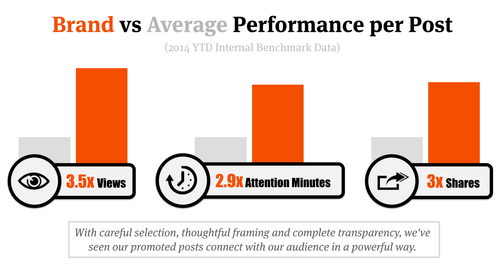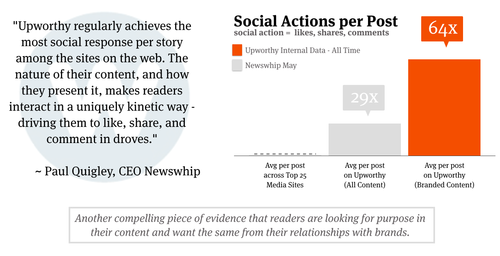Look Ma, Upworthy Is An Actual Business Now
You might wonder: What’s Upworthy’s business model? (Or you might not. If that’s the case, you can stop reading here since this whole post is about business-y stuff.)
We announced Upworthy’s plans to start running an actual makes-money-and-doesn’t-just-spend-it business back in April. You can read that whole post, but here’s the upshot: We decided to collaborate with brands and nonprofits to find topics of shared interest and get tons of people talking about them by highlighting the best of their content, curating great videos and graphics from across the web, and engaging Upworthy’s passionate, influential community to spread the word. Now, three months later, we’re here with an update on how it’s all going.
The good news: Our partners, both brands and not-for-profits, are signing up quickly and finding the collaborations extremely valuable. (We actually think this is part of a bigger trend of companies finding huge success connecting with consumers around shared values.)
A joint study between Google, TNS, and Ogilvy confirms what we’ve been seeing firsthand: There’s a real hunger in our society to connect with brands on a meaningful level, to see their advertising rooted in something purposeful and important. Celebrity exposés and cute-animal listicles aren’t the only things that can drive traffic and engagement on the Internet. Deep down, people want more than that and expect more from brands than just shiny new products.
The reaction from our audience to our collaborations is evidence of just this behavior. How do we know?

Statistically, our community is actually responding more strongly to branded posts than non-branded ones. Ad content sees more interactions per posts in terms of views, Attention Minutes, and shares than our average posts do. If this all sounds a little counterintuitive (“People hate ads! How could they be performing better on your site?!”), we think the key has actually been twofold: We try to be very thoughtful in the kinds of campaigns we’ll work with, and we’ve taken pains to be radically transparent with our community when content is connected with a paid campaign. That combination has been powerful in communicating that we’re both selective and stand for something, which we think has been valuable for our community and collaborators alike.
On a campaign level, we’ve been wholly pleased by how meaty and substantive our early campaigns have been. These collaborations have centered on issues that are important but not always easy to talk about — like our work with the GUESS Foundation on a campaign against sexual violence and norms of consent, with Unilever’s Project Sunlight on making the world better and more sustainable for our children, and with COVERGIRL on female empowerment.
We’ve worked with 12 brands and 13 nonprofits to lift up things that really matter. It's encouraging to see this approach working for them, as well:

It’s tempting to think that this early success stems from some wizard-like ability to conjure magical amounts of social action as we please — or even just our extra effort to make sure we get this right out of the gate. But when we broaden the comparison and look beyond Upworthy, we can see that there’s a bigger story here for purpose-driven content. Per post, our content drives 29x the shares versus the average of the top 25 media sites. Even more surprisingly, our branded content delivers 64x more than the top 25, branded or not.

So today, we’re happy to announce some really exciting new partners. Just this week we’re kicking off a collaboration with Pantene on their #sorrynotsorry campaign to talk about the unrealistic societal expectations women face. In the coming months, we’ll be collaborating with the U.S. Fund for UNICEF, Virgin Mobile, Nestle’s new all-natural line, Purina Beyond, and will be wrapping up a campaign to raise the minimum wage with Gap Inc. — all devoted to bringing attention to things that matter. We’re also excited for a unique partnership with IPG Mediabrands, one of the biggest global ad agencies, on a program designed to use advertising as a catalyst for social good (more details to come when it launches later this year).

Now don’t get us wrong — this process hasn’t been frictionless. With a passionate, engaged audience like ours, we knew we’d have to keep our eyes and ears open when introducing advertising onto the site. The advertising itself also required an adjustment period with our collaborators. After all, we weren’t just slapping banner ads on our page; we were asking partners to talk about real, significant topics from their point of view. But we’re getting better with time, learning what’s working from feedback and performance data, and adding more context and transparency with each new program.
It’s early yet, but we think we’re on to something here. We’ve approached advertising on Upworthy very carefully, and we’ll continue to do so. In just these first three months, Upworthy Collaborations has helped us hire folks to find and curate more and more of the stuff that our community cares about. We believe this is our best path to propel our mission forward.
We’ve always been rooted in and humbled by how many of you care about the issues that face our world. It’s what makes our site possible and what guides us when we take uncertain steps into unexplored territory. Upworthy community: Keep sharing and keeping us honest. Collaborators: Keep it coming!

